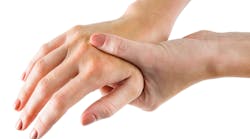We often hear about pain, injury, disability, and early retirement in the dental hygiene world. Practicing dental hygiene is an extremely physically demanding profession. When we work, we’re not using our musculoskeletal system as nature intended. Our musculoskeletal system (muscles, tendons, nerves, discs, and more) is meant to help us move dynamically through space. When we move our body in this fashion, we use it as it’s designed. For example, when you work out at the gym, even though you “feel the burn” and are out of breath, you’re using your body exactly how it’s intended.
Conversely, the body is not designed to hold you up in awkward postures for hours each day (think forward head posture, arm abduction, or flexed wrist). When you’re not in neutral posture (when your skeleton is in ideal alignment), you’re not allowing your strong bones to stabilize you. Instead, you’re asking that of your musculoskeletal system. Since you’re asking your soft tissue to do a job for which it is not designed, of course you will become injured, or at the very least, be in pain.
There are so many things I could say about ergonomics in dentistry. But here I’ll talk about something we all do: use excessive force when gripping things.
Read more by Stephanie Botts
Establishing the ideal posture for your practice: Let’s put it in neutral
Nearly 100% of hygienists have pain on the job. What can you do?
Try to avoid excessive force
We likely don’t think about this very much, but we’re constantly gripping, grabbing, pinching, and holding onto different items throughout the day. We have various instruments, handpieces, materials, and the air/water and suction. In addition, when holding onto these items, we also do some other kind of movement. For example, we could pinch our instrument while scaling, move our hand back and forth when using the air/water, or retract if we’re holding onto the suction or mirror. There is typically a combination of events for many work-related musculoskeletal disorders and injuries.
How often do you stop to assess how tightly you’re grabbing onto something? If you’re anything like I used to be when I practiced, the answer is probably not very much. But this is crucial when trying to prevent injury. Many of us use excessive pinch force when we work, which is relatively easy to change and can have an enormous payoff in the long run.
Pinch force is the force needed to hold onto an object with the fingers and thumb (figure 1). Force is a risk factor for ergonomic injuries.1 Obviously, we need to grip, grab, and hold onto things when we work. However, many of us use a death grip when doing these tasks, which puts us at risk of developing an injury. Some injuries from excessive pinch force are carpal tunnel syndrome, tendonitis, and trigger finger.2
Do we need to use a certain amount of force to grip things and do our job? Of course! Do many of us use too much force? We sure do! The good news is, with some awareness, we can reduce this risk and keep ourselves healthy.
Steps you can take
When you grip something, watch how tightly you hold it. Try to reduce the pressure just enough to hold the item securely, but no more. This habit takes some time, but the more you do it, the easier it will become.
Remember that ergonomic injuries typically happen due to a combination of events. So, if you’re holding onto the HVE or saliva ejector when you power scale (which I do not recommend), you’re likely using excessive pinch force. But you could also be using an awkward posture, such as an arm abduction (figure 2).
Two risk factors happen simultaneously that dramatically increase your risk of injury. Picture yourself using your polisher or handpiece with excessive force. Using the handpiece inherently has another ergonomic risk factor—vibration—so combining these two risk factors will increase your chances of injury.
Ergonomics truly is about every little thing you do daily in the operatory. It isn’t rocket science, but it’s also not as simple as “just doing it.” Ergonomic dental practice takes constant body awareness and assessment to ensure you care for yourself. You want to be sure you’re doing things that are helping you, not hurting you.
The next time you’re in the operatory, notice how tight your grip is and try to loosen it up!
References
1. Ergonomics. OSHA.gov. https://www.osha.gov/ergonomics. Accessed September 3rd, 2022
2. Gupta A, Bhat M, Mohammed T, Bansal N, Gupta G. Ergonomics in Dentistry. Int J Clin Pediatr Dent 2014;7(1):30-34.









